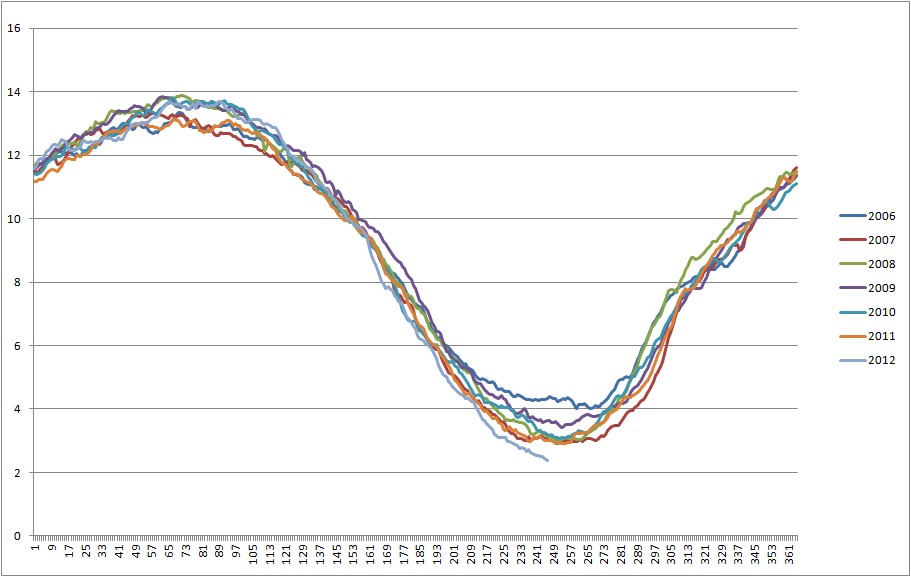I'm currently ploughing through my stack of Arctic related papers. It seems to me that in order to fully appreciate the spectacle I think the coming years will deliver, knowing the scientific literature is a pre-requisite. So over the autumn and winter I'll be making more of an effort to post commentaries on what I've been reading. One aspect of the fallout of this year is that there will be a series of papers by various researchers who've been following this year. I can't wait!
However along the way I'll be distracted from my campaign of re-reading and catching up with my 'to be read' folder by research I've not been aware of.
Like these papers...
Friday, 28 September 2012
Thursday, 20 September 2012
A Sea Ice Free Arctic by 2020 (and maybe sooner).
I've had this post in varying form for the last three weeks, I've dithered over posting for one reason and another, which has turned out to be for the best. That's because I can start this post with a perfect quote from Dr Julienne Stroeve.
I've been one of what has seemed at times like a minority of one in the amateur community following the loss of Arctic sea ice. My view had been that the ice was transitioning to a new pseudo-equilibrium state, one with an ice pack composed almost entirely of young ice. I now doubt that such a pseudo-equilibrium state exists, and I anticipate a rapid transition by 2020 to a virtually sea ice free state (NSIDC Extent <1M km^2), I suspect it could be much earlier than that.
The acceleration of the loss of the extent of the ice is mostly because the ice has been so thin. This would explain why it has melted so much this year. By June the ice edge had pulled back to where it normally is in September... .
..The 2007 record was set when you had weather conditions which were perfect for melting. This year we didn't have those. It was mixed. So this suggests the ice has got to a point where it's so thin it doesn't matter what the weather is, it's going to melt in the summer. This could become the new normal.Julienne Stroeve.
I've been one of what has seemed at times like a minority of one in the amateur community following the loss of Arctic sea ice. My view had been that the ice was transitioning to a new pseudo-equilibrium state, one with an ice pack composed almost entirely of young ice. I now doubt that such a pseudo-equilibrium state exists, and I anticipate a rapid transition by 2020 to a virtually sea ice free state (NSIDC Extent <1M km^2), I suspect it could be much earlier than that.
Sunday, 16 September 2012
The Early Summer Arctic Dipole.
The two papers introduced in the previous post offer some ideas as to what may be causing this change in atmospheric circulation. I've no doubt we'll see a number of interesting papers getting to the root cause of the shift to repeated early summer Arctic Dipole (AD) pattern since 2007. But what is known at present and what ideas are there about the cause?
Saturday, 15 September 2012
Summer Daze? The Arctic Dipole!
In my last post I updated a post from a year ago entitled Summer Daze in which I showed that a new pattern of sea level pressure anomalies has asserted itself in the wake of the sea ice crash of 2007. New research is out that examines this pattern, sheds some light on possible mechanisms behind it, and considers the implications.
Friday, 7 September 2012
Summer Daze 2012.
Last year I posted "Summer Daze." In that post I detailed a new pattern of atmospheric behaviour centred on high pressure over Greenland, this pattern is new since 2007, and as I showed is a robust change since the 1950s in NCEP/NCAR data.
Well, it's happened again this year...
Well, it's happened again this year...
Tuesday, 4 September 2012
Er, I really can't think of title for this one.
I've had a kickself simple idea about the summer loss of thickness in calculated thickness...
First off. A couple of weeks ago I posted "How Low Can it Go". In a nutshell I pointed out that 2007 and 2011, the previous two records, ground to a near halt in the last week of August, as the sun set on the central polar region. So I suggested that the same would happen this year.
It hasn't.
First off. A couple of weeks ago I posted "How Low Can it Go". In a nutshell I pointed out that 2007 and 2011, the previous two records, ground to a near halt in the last week of August, as the sun set on the central polar region. So I suggested that the same would happen this year.
It hasn't.
Sunday, 2 September 2012
What caused the volume loss in 2010?
I've previously discussed why I see 2010 as a key event in the loss of volume in the Arctic as modelled by PIOMAS, and that there is some indication this has an accompanying impact in satellite observation of sea ice area. But what caused the loss of volume in 2010?
Why the 2010 PIOMAS volume loss was important.
As regular readers of this blog will know, I've been going on about the volume loss of 2010 as an event that rivals 2007 in the PIOMAS model output. Earlier this year Chris Randles asked several people to help him with some PIOMAS data he'd just been made aware of. I was fortunate enough to be one of those people. I'll be posting about how to use the data in excel and posting links to derived graphics and spreadsheets later this week. But for now...
Subscribe to:
Comments (Atom)
